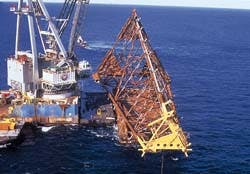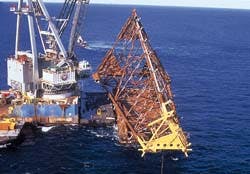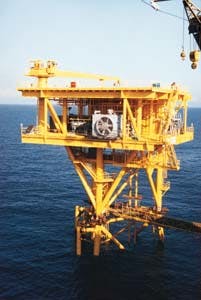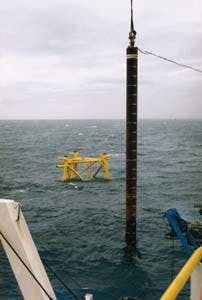MARGINAL FIELDS LL&E minimal platform concept proves viable for deeper water
Pacesetter tripod configuration allows for enhanced
stiffness, reduced bracing, and easier lift requirements
C. M. (Josh) Billings
Coastal Oil & Gas Corporation
(formerly with Louisiana Land & Exploration)Mark H. Doing
Mustang Engineering
The tripod jacket structure for LL&E Platform Blanco is shown being lifted off its transport barge by a McDermott barge. The structure, designed by Mustang Engineering, is the deepest yet for a minimal tripod design.
The use of minimal structure offshore oil and gas production systems has been attracting widespread attention in water depths shallower than 300 ft, and the structures have proven successful in marginal applications at those depths. Until now, there has been little significant progress with similar technology in water depths exceeding 400 ft.
The Louisiana Land and Exploration Company (LL&E) tripod platform (co-owned by OXY USA) recently installed in 428 ft of water at Vermilion Block 395 offshore Louisiana, however, represents a unique approach to effectively break through the 400-ft threshold for commercial viability.
Platform Blanco, as the platform is known, was an engineering and design challenge. It provided the optimum solution for economically obtaining production in a price-depressed gas market, at a water depth beyond jackup rig drilling capability, independently processing at the location, while being completed on a fast track schedule.
The project not only required numerous design considerations and planning for the platform's construction, but also coupled installation innovations to expedite the loadout and economically set the jacket and deck.
To achieve their goal, LL&E and structural design engineers, Mustang Engineering, considered several design possibilities, selected the fabrication and installation contractors early in the process, and involved them extensively throughout the project so that certain engineering options could be incorporated to better suit the contractors' specific capabilities. This coordination, and a team approach of all parties involved, helped assure the project's success.
Specifications
LL&E's Vermilion Block 395 structure has a skirt-piled tripod jacket. One 72-in.OD skirt pile per leg enables penetration to 338 ft by each 400-ft, 207-ton pile. The 1,525-ton jacket was designed for single lift and supports a three level deck, including a drill deck at 517 ft above the sea floor. Its design utilizes a five-slot conductor configuration, with a subsea template in place for two wells already drilled prior to setting the structure The four-leg deck, weighing 450 tons, can be categorized as an open design, promoting maximum open space, yet supporting the drilling rig, a 120-ft vent boom, heliport, pedestal crane and other major appurtenances. The structure is capable of handling a 1,000 hp self-contained drilling/workover rig or the Arethusa/ Neptune tender-assisted rig with skidded drawworks, allowing simultaneous drilling and production operations. Production facilities were designed for 40 MMcf/d of gas and 1,200 b/d of condensate, with initial peak capacities of 40 MMcf/d of sales gas and 200 b/d of condensate.
Design criteria
Prior to deciding on the final jacket configuration for the intended water depth, LL&E and Mustang investigated several alternative possibilities and previous design considerations.
Costs were compared using four pile vs. tripod concepts, with skirt or main piles, using launched or lifted installation. Preliminary studies focused on prior structures set in water depths to 650 ft over the past five years in the US Gulf of Mexico. The lifted tripod design was ultimately selected for its reduced material costs, quicker fabrication, and shorter installation time.
The intended water depth and the platform's natural period required independent certifications by a certified verification agent (CVA) for design, fabrication and installation. The platform was constructed to meet or exceed the requirements of the Minerals Management Service (MMS), the Code of Federal Regulations 30 CER 250, and meet API RP2A, 20th edition, factored to 19th edition reference level forces for its design life.
The structural design of the deck, jacket and foundation, undertaken by Mustang, relied on extensive computer programming, using SACS software for modeling, analysis, and design.
Dynamic wave effects, jacket fatigue life, and loadout and lift stresses were calculated using SACS programs. Seastate information was derived from environmental studies conducted for LL&E's previously installed platform at nearby Vermilion Block 412. The MOSES 3-D program was applied to simulate transportation motions and stresses as well as for flotation and upending calculations. Further, special studies were commissioned for vortex shedding and wave slam analysis, given the application and its increased potential for fatigue.
Engineering, fabrication
The tripod configuration and structural design provided a simplified geometry for efficient fabrication. Unlike a four-pile or other rectangular structure, the inherent stability of the triangular horizontal frame minimized cross bracing requirements. Additionally, the triangular shape presented a cross section to the derrick barge which allowed lifting at a close radius without fouling of boom.
The design utilized a combination of single diagonal members in the upper three bays (to elevation -190 ft), with X-bracing used on the remaining two bays at the bottom of the jacket. The number of bays were minimized by using intermediate conductor guide levels which further acted to provide bracing for the X-braces, thus avoiding compression-only inefficiency. Battered piles added stiffness to the jacket, reduced its natural period, and minimized the amount of required pile tonnage for support.
For facilities and drilling rig requirements, a four-leg deck configuration was used at the production and drilling deck levels, Because of its four-leg to three-leg reduction, the deck was necessarily designed with additional trusses and bracing, resulting in a heavier structure. It is estimated, however, that the tripod's total structural tonnage was still 10-15 percent less than that of a similar depth four-pile.
In order to accommodate the broadest spectrum of available installation equipment, the jacket structure was designed for either a single derrick lift with flotation or, as a contingency, a two derrick lift and rotation. Similarly, the battered skirt pile guide system design, was selected in order to provide for the best installation bid selection. It facilitated the use of either a slimline underwater hammer or a follower with above-water steam hammer for driving the piles. The jacket's mudmats were fabricated using tubulars and crimped plate as opposed to beam-reinforced plate, so that the jacket would retain its reserve buoyancy during flotation, allowing simple free-flooding of the skirt sleeves.
(Right) The completed jacket with deck installed can produce 40 MMcf/d and 1,200 b/d of condensate at full capacity.(Left) After upending and landing the tripod on the seafloor 428 ft below, the installation vessel prepares to lower a skirt pile.
Loadout, installation
Loadout was made from Gulf Island Fabricator's facility in Houma, Louisiana in March 1995. The platform design utilized a four-point loadout and tiedown system that facilitated the use of skid shoes for loadout. The procedure also allowed for reasonable barge levelness tolerances, simplified the tiedown configuration and subsequent tiedown removal, and localized the jacket's stress points, leading to a minimum of added tonnage for installation considerations.
Installation contractor J. Ray McDermott used a single hook lift to float the jacket, and a two block approach from the single crane for upending. The jacket was lifted from the two waterline legs with the No. 2 block and the third leg with the No 1 block, resulting in greater stability than could have been accomplished with a single block lift. Special side-lift trunions were designed and fabricated to facilitate rigging and to prevent interference with the piles during installation. The jacket was stabbed over two docking piles, installed during drilling operations, which protected the two mudline suspended wells from impact during jacket placement.
Pile grouting benefited from new design and application technology that both reduced setup time and provided cost savings. Because the installation contractor foresaw potential pile driving vibration damage to the grout lines, grouting was employed through the use of an ROV with flexible hose inserted directly into the skirt's grout valves. The skirt sleeves were also fitted with two sets of Crux grout seals, a new technology that eliminated the need for running packer inflation lines to the surface and facilitated the grouting process, while providing 100% redundancy.
Platform Blanco was designed with oversized 600-ton capacity hydraulic grippers, integral to each skirt sleeve. In what is believed to be the first such application, the grippers were
used not only to assist in leveling the jacket and holding it motionless, but also to support weight of the deck during grout curing. This innovative use of these grippers allowed the deck to be set early, effectively reducing installation time by about eight hours
Pacesetter design
Platform Blanco represents a new class of structure, leading to what could ultimately become a trend for economically producing from marginal fields in deeper water using minimal, multi-task platforms.
LL&E's Blanco provided a solution, combining the minimal nature of the structure with the robustness needed to support drilling and production operations in 400 ft plus water depths. The success of future projects, however, necessitates the adaptation of existing design principles to these extended environments, the utilization of new technology for problem solving, and the teamwork of all project participants.
C. M. (Josh) Billings was the project manager for LL&E's Platform Blanco. He is currently manager of offshore construction for Coastal Oil & Gas Corporation. He holds a BME from the University of Missouri at Rolla and has more than 20 years experience in the oil and gas industry.
Copyright 1995 Offshore. All Rights Reserved.



